Introduction
Energy drinks are widely used across the globe for maintaining high energy level in a shorter span of time. This increasing trend in the use of energy drink among youngsters is mainly because of marketing efforts focusing millennial generation. In Europe and Asia, the energy drink was first introduced in 1960’s. It is also assumed that introduction of “Red Bull” in 1987 in Austria and in 1997 in the USA through aggressive marketing was another contributing factor for recent increase in use of high caffeine content energy drinks.1 Energy drinks are categorized as “functional foods” mainly due to the presence of caffeine, and other substances such as taurine, riboflavin, pyridoxine, nicotinamide, other B vitamins, and various herbal derivatives.2
Millennials are the young generation mostly falling in birth year from 1980 to 2000. Mintel,3 a global research firm indicated that millennials in the age group range of 27 to 37 years had showed an increase in consumption of energy drink from 55 to 61 % in 2015 compared with 2014. Center for Food Safety and Applied Nutrition adverse event reporting system (CAERS) found that adverse events reported to Food and Drug Administration (FDA) between January 1, 2004 and October 23, 2012 were related to nervous, endocrine, gastrointestinal, cardiovascular, respiratory, musculoskeletal, urinary, reproductive, and immune system. Ingredients of energy drinks vary in different brands.
Caffeine is most widely used active ingredient in energy drink due to its stimulant effect on central nervous system. Another ingredient found in most energy drinks is guarana, also known as Brazilian cocoa or zoom which contains 3.6% to 5.8% of caffeine.4
The Food and Drug Administration (FDA) has set the maximum concentration of caffeine in cola beverages at 32.4 mg of caffeine per 6-oz bottle or 65 mg of caffeine per 12-oz bottle.5 Caffeine overdose is hazardous and life threatening. FDA has reported a death of a 19 year old college student after taking an overdose of caffeine tablets.6 Caffeine has been found to affect the psychomotor and cognitive performance,7-9 physical activity,10 cardiovascular system,11,12 and respiration. Caffeine consumption also produces its effects on insulin activity, lipid metabolism,13,14 lactation, pregnancy and reproductive system.8 Withdrawal of caffeine by regular users is associated with temporary adverse effects such as increased incidence of headache, drowsiness and fatigue.7 Caffeine is found to be addictive although with a very low addictive potential.15
Taurine, the most abundant intracellular amino acid in body is also used in energy drinks, it is linked with the maintenance of normal glucose levels in blood and decreased serum cholesterol and triglycerol concentration have effects on heart and vascular system.16 Taurine is essential for muscular contractile process and it also have antiarrythmic effect.17 Oxidative stress that results from exercise performance can be antagonized by taurine.18 Taurine may start accumulating and exhibit adverse effects like dizziness and vertigo.19 It is also hypothesized that combinatorial use of caffeine with taurine greatly increases ventricular function.20
Riboflavin has been shown to improve work performance but same effect in those individuals who are with normal dietary intake, is not well established. It is studied that exercise accelerates riboflavin depletion in body and hence there is a need to increase riboflavin intake.21,22 Toxic effects of riboflavin are not very common as they require significantly high doses.23
Pyridoxine is involved in amino acid metabolism.24 High doses of vitamin B6 are toxic and can cause bloating, depression, fatigue, irritability, headache and nerve damage.25
The aim of this research is to evaluate understanding of associated health risk by the use of energy drink in millennial generation of one of the largest city of the world.
Methodology
Qualitative, descriptive, study was performed using a questionnaire comprising of 11 questions from the months from March till June, 2016. All participants gave their informed consent for the study and the study was conducted in accordance with the Declaration of Helsinki. In addition to the questions, first section addressed demographic information (Age, Gender and educational affiliation). First question attempted to inquire about what measure (energy drink or any other) participant usually take in order to avoid sleep or stay awake. Remainder of questions were more focused on Energy drinks, general awareness, frequency of consumption, adverse effects (awareness and experience) and Addiction potential. A section invited additional comments if any. Final section informed participants that their name and affiliation will not be made public. Young students were merely the target audience; Questionnaire was circulated among 205 students of Karachi, Pakistan; participants belonged to different schools, colleges, institutes and universities irrespective of their course of study of Karachi, Pakistan. Results were analyzed using SPSS.21 Responses were primarily evaluated using simple descriptive measures. Mann-Whitney U Test was applied to investigate the impact of gender on incidence of headache and palpitations, and on opinions regarding hazardous nature of the products used to stay alert and frequency of consumption. Statistical significance was accepted at the 95% confidence level (p<0.05). Friedman test was applied to see difference in opinion regarding incidence of adverse effects on different organ systems. Post hoc analysis with Wilcoxon signed-rank tests was conducted with a Bonferroni correction applied, resulting in a significance level set at p < 0.0003 equivalent to p <0.05). A Bonferroni correction is needed to prevent type I error when comparing multiple samples using Wilcoxon signed-rank test; originally supposed value of significance level (in this case, 0.05) is divided by the number of comparisons (in this case, 15).
Results
Demography
A total of 205 students completed the survey. 56.6% of respondents were female, rest (43.4%) being male. Study participant comprised a larger proportion (88.8%) of those who were aged between 18 – 25 years, with a smaller proportion of individuals aged below 18 years (5.9%) or above 25 years (5.4%). The largest proportion of partakers was undergraduate students (65.2%).
Drinking behavior
Most of the young students (32.8%) utilize tea for staying awake or alert. Second highest proportion (25.3%) of participants perform miscellaneous (other) activities like washing face, watching TV or using internet on mobile phone to stay awake or alert, followed by 17.4% of those who drink coffee. 4.9% relied on tea and coffee both. 4.4% consumed soft drinks for this purpose. Only 1% of youngsters exclusively consume energy drinks for staying awake or alert.
A small fraction (2.9%) of participants consume 10 or more drinks per week for this purpose. Most of participants (49.2%) do not routinely consume energy drinks, while those who do, are predominated by once in a week drinkers (30.2%) followed by those who take 2-5 (15.6%), 6-9 (1.9%) and 10 or more (2.9%) drinks per week. (Figure 1)
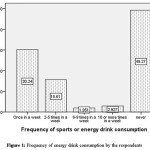 |
Figure 1: Frequency of energy drink consumption by the respondents Click here to View figure |
General opinion regarding energy drinks
50.6% of young students agree that energy products can help us in staying awake or alert. 70.1% think that things we consume to stay awake or alert may be hazardous to health. 88.8% of participants believe that consuming high amount of energy drinks can pose serious health risk.74.7% assume that energy drink usage may be addicting. (Table 1).
Table 1: General opinion of respondents related to energy products
| Responses | Yes | No |
| Do you think energy drinks can help stay awake or alert? | 50.60% | 49.40% |
| Do you think things that we consume to stay awake or alert may Hazardous to Health? | 70.10% | 29.90% |
| Do you think consuming high quantity of energy drinks can be Serious health risk? | 88.80% | 11.20% |
| Do you think energy drinks can cause dependence | 74.70% | 25.30% |
| Have you ever felt headache after taking energy drinks? | 10.60% | 89.40% |
| Have you ever felt palpitations after taking energy drinks? | 12.90% | 87.10% |
Opinion and experiences related to health hazards
Notable proportion of study participants (16.1%) has experienced headache and a similar share (15.2%) report palpitations after taking energy drinks. 18.1%, 24.7%, 27.9%, 36.2%, 23% and 34% of participants disagree with incidence of adverse effects related Cardiovascular system, Behavior, Liver, Senses, Gastrointestinal tract and Lungs respectively with the use or overuse of Energy drinks as shown in figure 2-7.
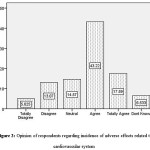 |
Figure 2: Opinion of respondents regarding incidence of adverse effects related to cardiovascular system Click here to View figure |
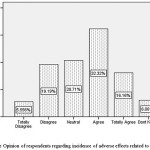 |
Figure 3: Opinion of respondents regarding incidence of adverse effects related to behavior Click here to View figure |
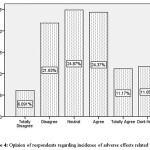 |
Figure 4: Opinion of respondents regarding incidence of adverse effects related to liver Click here to View figure |
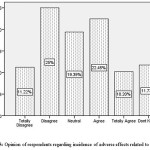 |
Figure 5: Opinion of respondents regarding incidence of adverse effects related to senses Click here to View figure |
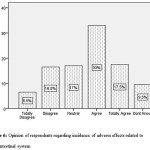 |
Figure 6: Opinion of respondents regarding incidence of adverse effects related to gastrointestinal system Click here to View figure |
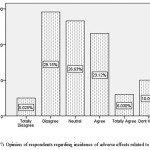 |
Figure 7: Opinion of respondents regarding incidence of adverse effects related to lungs. Click here to View figure |
As reported by the participants, gender was found to have no significant impact on incidence of headache (U = 4141.0, p = 0.067) and palpitations (U = 4323.0, p = 0.441). On the counterpart, opinion regarding hazardous nature of products with alerting action was dependent on gender (U = 4334.0, p = 0.024). Similarly, frequency of consumption was found to be different amongst males and females (U = 4165.5, p = 0 .010).
Friedman test demonstrated that there was a statistically significant difference in opinion related to the incidence of adverse effects on different organ systems, χ2(2) = 33.015, p = 0.000. Post hoc analysis (Table 2) shows statistically significant differences in opinions related to incidence of adverse effects were observed only between comparison of Heart and vessels to lungs (Z = -4.62, p = 0.000), Heart and vessels to Senses (Z = -3.89, p = 0.000) and GIT to lungs (Z = -3.93, p = 0.000). Median (IQR) for opinion related to incidence of adverse effects on heart and vessels, lung, liver, senses and GIT were 3 (2 to 3), 2 (1 to 2), 3 (1.25 to 3), 2 (1 to 3), 2 (1 to 3) and 3 (2 to 4) respectively. Where, 0, 1, 2, 3, 4 and 5 were assigned as totally disagree, disagree, neutral, agree, totally agree and don’t know respectively.
Table 2: Post hoc (Friedman test) analysis on opinions related to the incidence of adverse effects
| Z | Asymp. Sig. | |
| (2-tailed) | ||
| Related to lungs – Related to heart and vessels | -4.625b | 0* |
| Related to behavior – Related to heart and vessels | -2.229b | 0.026 |
| Related to Liver – Related to heart and vessels | -2.927b | 0.003 |
| Related to senses – Related to heart and vessels | -3.890b | 0* |
| Related to GIT – Related to heart and vessels | -1.007b | 0.314 |
| Related to behavior – Related to lungs | -2.305c | 0.021 |
| Related to Liver – Related to lungs | -1.983c | 0.047 |
| Related to senses – Related to lungs | -.313c | 0.754 |
| Related to GIT – Related to lungs | -3.934c | 0* |
| Related to Liver – Related to behavior | -.503b | 0.615 |
| Related to senses – Related to behavior | -2.029b | 0.042 |
| Related to GIT – Related to behavior | -1.331c | 0.183 |
| Related to senses – Related to Liver | -1.612b | 0.107 |
| Related to GIT – Related to Liver | -1.793c | 0.073 |
| Related to GIT – Related to senses | -3.107c | 0.002* |
| a. Wilcoxon Signed Ranks Test | ||
| b. Based on positive ranks. | ||
| c. Based on negative ranks. | ||
| * significant at p value < 0.005 | ||
Discussions
Current study focused on the consumption behavior among youngsters, Similar type of study was performed by Malinauskas26 et.al., Velazquez27 et.al., among college students. Generally energy drinks are thought to be exceedingly safe products making them usable without caution. This permit uncontrolled consumption pattern, especially amongst youngsters. Besides all this safety in mind, energy drinks have had been reported to cause problematical scenarios of varying seriousness.28,29 Though these adverse conditions are not very common but certain factors play their role in bringing them up. These factors may include net amount of functional content consumed or of combination of different functional contents with similar risk profile, intensified by the underlying susceptibility of individual. Increased sensitivity to any of functional component and underlying pathological condition or risk factor, all are supposed to affect individuals’ susceptibility. It is evident from the survey that energy drinks are not mainstay for staying awake or alert amongst youth of our society. Rather tea is most frequently employed for the said purpose, followed by performing miscellaneous activities that help stay awake and drinking coffee. Not exploited for the sake of wakefulness, even though significant routine consumption of energy drinks is reported. Majority of participants are reported to believe that energy drinks and similar products can become hazardous with overzealous use, while those who deny this fact cannot be neglected. Caffeine has an stimulant effect while given in combination with taurine, it showed no effect on short-term memory.30,31 Variation in caffeine sensitivity may be reflected by the incidence of headache and palpitations among users.
Mann-Whitney U Test demonstrated that incidence of headache and palpitations as reported are not gender dependent. On the other hand opinion related to hazardous nature of products used to stay awake was significantly different between two genders. Females in this case are more cautious. Another important variation was found in the frequency of consumption which varies significantly in males (median= 2-3 drinks per week) as compared to females (median = zero drinks per week). This is in alignment with the previous statement, this lower weekly consumption is most probably due to the perception amongst females regarding to the hazardous nature of such products. Proportion of population that disagree with the incidence of adverse effects associated with the use of energy drinks are noticeable and this portion of population is at the highest risk because in such situations potential for uncontrolled usage is highest, pointing towards need for increasing awareness of general population to make them realize of possible malady.
Conclusion
It is clear from the above research that millennial used energy drink even they know the associated potential health risk.
Suggestion
We need to carefully deal with the circumstances to keep society away from the potential hazards of these otherwise safe products. It is advised that government of the country consider regulating such products. Permissible limits of caffeine and other functional components should be declared and monitored in the products being marketed. Furthermore labeling guidelines should be introduced and regulated ensuring that consumer is informed of the caffeine, other functional components and their amount in the product. High risk groups can be defined on the labels too. Mentioning maximal daily consumption limit can also be helpful.
Acknowledgements
The authors need to acknowledge the efforts of Fahad Siddiqui (University of Karachi) for his contribution in knowledge sharing for this article.
Funding Source
The research work for this article is self funded.
Conflict of Interest
All authors declare that there is no conflict of interest with any person or organization in term of financial, technical, personal or any other mean.
References
- Reissig CJ, Strain EC, Griffiths RR. Caffeinated energy drinks—a growing problem. Drug and Alcohol Dependence. 2009;99(1):1-10.
CrossRef - Aranda M, Morlock G. Simultaneous determination of riboflavin, pyridoxine, nicotinamide, caffeine and taurine in energy drinks by planar chromatography-multiple detection with confirmation by electrospray ionization mass spectrometry. Journal of Chromatography A. 2006;1131(1):253-260.
CrossRef - Bailey S. Energy Drinks Continue to Thrive despite Controversies: Market Realist.2015.
- Jellin JM, Gregory PJ. Natural medicines comprehensive database: Therapeutic Research Faculty. 2009.
- FDA. Food and Drug Administration Proposed rule. Caffeine in nonalcoholic carbonated beverages. Fed. Regist. Docket. 987;82N-0318.
- FDA. Medicines in my Home: Caffeine and Your Body. 2007.
- Rogers PJ, Dernoncourt C. Regular caffeine consumption: a balance of adverse and beneficial effects for mood and psychomotor performance. Pharmacology Biochemistry and Behavior. 1998;59(4):1039-1045.
CrossRef - Nawrot P, Jordan S, Eastwood J, Rotstein J, Hugenholtz A, Feeley M. Effects of caffeine on human health. Food Additives & Contaminants. 2003;20(1):1-30.
CrossRef - Nardi AE, Lopes FL, Freire RC, et al. Panic disorder and social anxiety disorder subtypes in a caffeine challenge test. Psychiatry research. 2009;169(2):149-153.
CrossRef - Beck TW, Housh TJ, Schmidt RJ, et al. The acute effects of a caffeine-containing supplement on strength, muscular endurance, and anaerobic capabilities. The Journal of Strength & Conditioning Research. 2006;20(3):506-510.
- Daniels JW, Molé PA, Shaffrath JD, Stebbins CL. Effects of caffeine on blood pressure, heart rate, and forearm blood flow during dynamic leg exercise. Journal of Applied Physiology. 1998;85(1):154-159.
CrossRef - Robertson D, Wade D, Workman R, Woosley RL, Oates J. Tolerance to the humoral and hemodynamic effects of caffeine in man. Journal of Clinical Investigation. 1981;67(4):1111.
CrossRef - Sherman H, Gutman R, Chapnik N, Meylan J, Le Coutre J, Froy O. Caffeine alters circadian rhythms and expression of disease and metabolic markers. The international journal of biochemistry & cell biology. 2011;43(5):829-838.
CrossRef - Westerterp-Plantenga M. Green tea catechins, caffeine and body-weight regulation. Physiology & behavior. 2010;100(1):42-46.
CrossRef - Nehlig A, Boyet S. Dose–response study of caffeine effects on cerebral functional activity with a specific focus on dependence. Brain research. 2000;858(1):71-77.
CrossRef - Lourenco R, Camilo M. Taurine: a conditionally essential amino acid in humans? An overview in health and disease. Nutr Hosp. 2002;17(6):262-270.
- Talwar G, Srivastava L. Textbook of biochemistry and human biology: PHI Learning Pvt. Ltd. 2002.
- Miyazaki T, Matsuzaki Y, Ikegami T, et al. Optimal and effective oral dose of taurine to prolong exercise performance in rat. Amino Acids. 2004;27(3-4):291-298.
CrossRef - Suliman ME, Bárány P, Divino Filho JC, Lindholm B, Bergström J. Accumulation of taurine in patients with renal failure. Nephrology Dialysis Transplantation. 2002;17(3):528-529.
CrossRef - Kim W. Debunking the effects of taurine in Red Bull energy drink. Nutrition Bytes. 2003;9(1).
- Powers HJ. Riboflavin (vitamin B-2) and health. The American journal of clinical nutrition. 2003;77(6):1352-1360.
- Belko AZ, Obarzanek E, Kalkwarf HJ, et al. Effects of exercise on riboflavin requirements of young women. The American journal of clinical nutrition. 1983;37(4):509-517.
CrossRef - Health R. Healing with vitamins: Straight from Nature, Backed by Science–The Best Nutrients to Slow, Stop, and Reverse Disease. New York: PA: Rodale Books, Inc. 2009.
- Puri D. Textbook of medical biochemistry. Elsevier, New Delhi. 2011.
- Fox PF, McSweeney PL. Dairy chemistry and biochemistry: Springer. 1998.
- Malinauskas BM, Aeby VG, Overton RF, Carpenter-Aeby T, Barber-Heidal K. A survey of energy drink consumption patterns among college students. Nutrition journal. 2007;6(1):35.
CrossRef - Velazquez CE, Poulos NS, Latimer LA, Pasch KE. Associations between energy drink consumption and alcohol use behaviors among college students. Drug and alcohol dependence. 2012;123(1):167-172.
CrossRef - CAERS. CAERS Adverse Events Reports Allegedly Related to Energy Drinks. 2012.
- CAERS. CAERS Adverse Events Reports Allegedly Related to Red Bull. 2012.
- Smit H, Cotton J, Hughes S, Rogers P. Mood and cognitive performance effects of” energy” drink constituents: caffeine, glucose and carbonation. Nutritional neuroscience. 2004;7(3):127-139.
CrossRef - Bichler A, Swenson A, Harris M. A combination of caffeine and taurine has no effect on short term memory but induces changes in heart rate and mean arterial blood pressure. Amino acids. 2006;31(4):471-476.
CrossRef

This work is licensed under a Creative Commons Attribution 4.0 International License.





